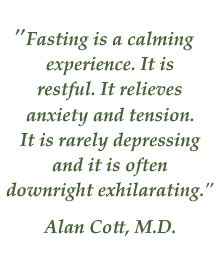Intermittent Fasting
There's a reason for the momentum behind the popularity of intermittent fasting: research is showing a variety of positive health benefits attained through intermittent fasting. Improved heart health, increased brain function, prevention of chronic diseases, increased life span, and loss of weight are some of the effects noted.
Proponents of fasting and nutritional healing have known about these benefits of fasting for a long time. But with this line of research perhaps we're a step closer to our medical community embracing fasting as the therapeutic practice it is. Currently, the surge in popularity is due to the increased interest in losing weight.
As the name implies, intermittent fasting is alternating between periods of eating normally and periods of fasting. These "periods" are open to user definition.
The varying schedules of intermittent fasting are usually based on one or more of the following intentions:
- losing weight
- extending lifespan
- enjoying the benefits of fasting
- adherence to religious traditions
Intermittent fasting, or IF as it is now popularly abbreviated, is thought to be as old as man. Whether gatherer or hunter, man is thought to have experienced both feasts and scarcities. And Orthodox Christians follow a long-held tradition of withholding foods at appointed times.
Common schedules for intermittent fasting
Alternate day fasting

Alternate day fasting is also called "every other day fasting", and is based on a 48 hour rhythm, fasting every other day and eating to satisfaction on the other days.
This is mostly practiced by those wishing to lose weight as their primary objective. It is valued as an alternative to calorie restriction, because studies on rats and monkeys are showing it to have the same valuable effects as caloric restriction without the negative emotional and physical effects.
Caloric restriction is known to produce a long list of health benefits, like lower cholesterol, lower blood pressure, fewer degenerative diseases, and of course, weight loss.
So you might think these lab rats experienced the beneficial effects to their health because eating every other day, they must have been ingesting half the calories as usual, and thus enduring calorie restriction. But that isn't so. They actually ate twice the calories on the days they were allowed food, making their total caloric intake the same as the control rats who were eating "free choice" every day.
You can see why this is such a wonderful revelation to the diet world. Rather than watching what you eat every day, you simply stop eating every other day. On the days you do eat, there is no need to count calories or fret over each meal. You just eat to satisfaction.
Concern over this as a diet plan arise when healthy foods aren't stressed and poor eating habits can go unchecked on "eating days". Yo-yoing between no food and junk food isn't going to put you in the best of health, it's apt to create a heavier burden on the body.
From a pure fasting standpoint, fasting every other day is considered too often. One day per week is considered appropriate for maintaining health. (See How Long Should You Fast page.)
Dr. Michael R. Eades has come up with a schedule of alternate day fasting that fits in better with our human cycles of eating and sleeping. In his plan, food is consumed every day, but at different times each day. Read his blog entry for more information on his schedule plan and on intermittent fasting research.
One day per week fasting
One day per week fasting has been advocated for many years now as a healthful fasting practice. By current terminology, it is now considered a form of "intermittent fasting".
The one day per week allows for rest and cleansing of our bodies, an antidote for our rich diets and toxic-laden world. It is often prescribed as a continuing maintenance schedule after cleansing and therapeutic fasts of greater duration have been performed. Generally, one day per week and/or three days per month and/or 1-2 weeks per year are used for this purpose.
A diet utilizing one day per week fasting is becoming popular with the ebook Eat Stop Eat, by Brad Pilon (this is an affiliate link). This is a diet plan for losing weight, where Pilon suggests a schedule of fasting 1-2 days per week. Again, only one day per week is recommended for fasting.
24-hour plans of intermittent fasting
These plans break the day into defined fasting periods and eating periods, also called "eating windows". These periods vary from plan to plan, but most define "eating windows" as periods ranging from four to eight hours, and abstention the other 16-20 hours. Rather than total abstention from food, with only water allowed, some plans suggest juices and/or fruit be allowed during the 16-20 hour fasting period.
Examples of plans based on the 24-hour rhythm:
"Unto the 9th hour" fasting
This an ancient form of intermittent fasting, where one abstains from food
til 3 p.m. If your day were to start at 6 a.m., 3 p.m. would be the ninth hour.
One plan, from Annemarie Colbin (author of Food and Healing), is to have a light snack of fruit
or raw vegetables at 3 p.m., then a regular nutritious and wholesome dinner at 6:00 p.m. Between 6 p.m.
and 3 p.m. the next day, you only ingest water, tea, or juice. This form of intermittent fast would be
said to have an "eating window" of three hours, from 3 p.m. to 6 p.m.
One meal per day
"One meal per day" is another type of intermittent fasting. One can choose the timing of the
one meal according to their own schedule and lifestyle.
If you do well with a large breakfast, make that your one meal. But most do better with an evening meal,
reserving the higher energy experienced during abstention for daytime activities. Digestion requires energy
and is best suited to the evenings when most of us are winding down our outer activities anyway.
In The New Detox Diet, Elson Haas, M.D., offers what he calls the "one-meal-a-day plan", used as a
transition that progresses toward a one-day fast, then to longer fasting. He suggests the one meal be
around 3 p.m. and consist of a protein and a vegetable, such as fish and a salad, or of a starch and a
vegetable, such as rice and steamed vegetables. During the hours of abstention, he suggests fresh fruit
and vegetable snacks be allowed in addition to liquids.
Natural nightly fasting
This kind of natural fasting occurs during our sleep, for approximately 8-12 hours. The sooner we stop eating in the evening, the longer this fast becomes, and the more the body can benefit from it. Like any fasting method, internal energy is freed up that can then be used toward the cleansing and healing of bodily tissues.
Intermittent fasting helps bring balance
All of these intermittent fasting methods allow for a period of time to be given for the rest and recuperation of the body. Some voice concerns that these patterns of eating can wreak havoc with their metabolism. It may, but it may not. Many do quite well, enjoying high levels of energy. You have to experiment some to find out your unique reactions.
During your eating periods, upgrade your food choices as much as possible. Be sure to soak your grains before cooking and avoid microwaved foods.
If you live in (or travel to) a cold climate, you might need to make alterations to your schedule accordingly. For some, keeping warm in cold weather requires eating more frequently. I can eat one meal a day in the summer and do fine, but in the winter I begin to get chilled easily and have to eat more often.
We're always happiest when we find balance. Intermittent fasting, used correctly, is simply balancing eating with not eating. American culture embraces eating as a 24/7 activity, and perhaps intermittent fasting, even as small as a skipped meal occasionally, can help bring us back toward balance.
More information on intermittent fasting
In 2014, Mark Mattson did a TEDx talk on intermittent fasting. As Chief of the Laboratory of Neuroscience at the National Institute on Aging and a professor of Neuroscience at The Johns Hopkins University, his research is showing the value of intermittent fasting.
This talk is 16 minutes in length.
Return to top
Return from Intermittent Fasting page to Types of Fasting page
Related Pages
Health Conditions Improved by Fasting. See the
long list of ailments that are known to respond well to fasting.The real benefits of Fasting for Weight Loss, affecting deep and lasting changes in our lives.
Cleansing Diets offers guidance on using a cleansing diet as a partial fast or as a means of preparation for other types of fasting.
Fruit Fast Details how to do a 1-3 day fast with apples.
What Is Fasting? Dispels any doubts about fasting being akin to starvation.
Recent Posts
-
Valter Longo and the Longevity Diet
Valter Longo's Longevity Diet, which is a fasting mimicking diet, is showing great promise as a prescribed therapy. If you haven't heard of Valter Longo, check out his newly launched website to follow… -
Fasting Overview for Beginners
Information on fasting especially geared toward the beginner. Important guidelines on fasting including the contraindications and how to do a simple one-day fast. -
Meat vs. Vegan | AllAboutFasting
Confusion seems to arise as to whether this site promotes meat-eating or veganism. Let's set the record straight and talk about ideal diets. Ideal for whom? Each of us individually.
